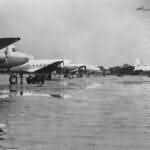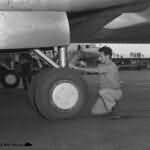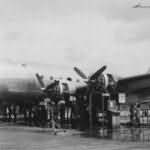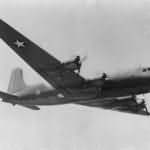Skymaster 42-107451 1944 Italy
R5D-1 39180 NATS Guam
R5D on Hickam Field
Skymasters on Yontan Airfield
Skymasters on Yontan Airfield
R5D 50865 1945
Skymaster Yontan Airfield June 1945
R5D 39173 Kwajalein
Light Tank T9 (Airborne) under belly of C-54
General MacArthur leaves his plane to step onto Japanese soil at Atsugi Airport 28 August 1945
C-54G Skymaster
C-54G 45-521
C-54B 44-9024 India
C-54B 43-17145
C-54A 42-107457
C-54A 42-72251 Guam
C-54 main landing gear
C-54 main landing gear
C-54 Hawaii 1944
C-54 FLEETWING
C-54 CBI 1943
C-54 Burma 1944
C-54 42-72626
India September 1945
C-54 42-72369 1945
C-54 42-72333 Leyte
Skymasters 42-72309 and 43-17130 Saipan 1944
Skymaster 41-37316 and R5D 39156 Kwajalein
Medevac aircraft on Funafuti
Medevac aircraft
C-54 41-37288 New Zealand September 1943
C-54 41-20137
1st Chicago Built Douglas Skymaster
R5D 90391 Oahu
C-54 41-37288
R5D in flight
C-54 42-107443 New Zealand 1944
Medevac C-54B 43-17129
C-54 41-37315 Funafuti
C-54 41-20141 Egypt
Warming Up NATS R5D 50865 on Hickam Field
C-54s and C-47 at Chengkung 1945
C-54 Skymaster in air
R5D Skymaster 1-R-201 of the VR-1 on the ground somewhere in the ETO on January 27, 1944
Mail for U.S Troops on Saipan delivered by R5D 11-R-22 from VR-11 and ox-drawn cart
Gen. Eisenhower’s C-54 rolls off Douglas assembly line in Santa Monica 1945
Douglas C-54 Skymaster transport plane
Douglas C-54 serial 42-32936 August 1942
R5D-1 BuNo 50844 in flight
Douglas C-54 Skymaster in flight 1942
Four-engined transport aircraft used by the United States Army Air Forces and U.S Navy in World War II and the Korean War.
General Specifications
- Type: Four-engined medium and long-range troop or cargo transport.
- Wings: Low-wing cantilever monoplane with constant taper from roots to tips. The wing section is NACA 23016/23012, with a 4-degree incidence at the root and a 7-degree dihedral. The wings consist of a three-spar center section with self-sealing fuel tanks integrated into the structure and a single main spar in the outer wings. The structure includes former ribs, spanwise stringers, and a smooth Alclad skin. NACA slotted flaps extend from the fuselage to the ailerons, with controllable tabs in the starboard aileron.
- Fuselage: Semi-monocoque all-metal structure with transverse frames, longitudinal stringers, and a flush-riveted smooth Alclad skin.
- Tail Unit: Cantilever monoplane type with two-spar frames covered with smooth Alclad sheet. The rudder and elevators are statically, aerodynamically, and dynamically balanced, with fabric covering for the rudder and metal leading edges for the elevators.
Landing Gear
- Configuration: Retractable tricycle type, with twin-wheels and single shock-strut on the main gear, and a single steerable nose wheel. Hydraulic retraction system with manual emergency gear extension. The main wheels retract forward into inboard engine nacelles, while the nose wheel retracts backward into the fuselage.
Power Plant
- Engines: Four Pratt & Whitney R-2000-7 or 11 fourteen-cylinder radial air-cooled engines, each with two-speed superchargers, capable of producing 1,350 hp for takeoff and varying power outputs at different altitudes.
- Propellers: Four-bladed Hamilton-Standard Hydromatic constant-speed full-feathering airscrews, 13 ft. 2 in. (4 m) in diameter.
- Fuel and Oil Systems: Fuel tanks are located in both the fuselage and wings, with additional oil tanks in each engine nacelle and an auxiliary oil tank in the fuselage.
Accommodation and Interior
- Crew: Six members including pilot, co-pilot, navigator, radio operator, and two relief crew members. The crew compartment includes facilities such as rest bunks, toilet, water tank, and storage for parachutes and life rafts.
- Passenger/Cargo Configuration:
- C-54: Equipped with 26 seats, overhead baggage racks, and provisions for life rafts, coatroom, buffet, food storage, and lavatory facilities. The cargo compartment is equipped with tie-down fittings and can carry external loads.
- C-54A: Designed for troop transport with benches instead of seats, reinforced flooring, and cargo handling equipment, including a built-in twin-boom hoist.
- C-54B and C-54E: Modified configurations for different missions, including fuel tank rearrangement and additional fittings for passenger or cargo adaptability.
Dimensions and Performance
- Dimensions:
- Span: 117 ft. 6 in. (35.8 m)
- Length: 93 ft. 11 in. (28.6 m)
- Height: 27 ft. 6⅜ in. (8.4 m)
- Wing Area: 1,462 sq. ft. (135.8 sq. m)
- Weights:
- C-54: Empty weight 36,400 lbs. (16,526 kg); loaded weight 62,000 lbs. (28,150 kg).
- C-54A: Empty weight 37,300 lbs. (16,934 kg); maximum loaded weight 65,000 lbs. (29,510 kg).
- C-54B: Empty weight 38,200 lbs. (17,343 kg); maximum loaded weight 73,000 lbs. (33,142 kg).
- Performance:
- Maximum Speed: 274 mph (438 km/h) at 14,000 ft. (4,270 m)
- Cruising Speed: 239 mph (382 km/h) at 15,200 ft. (4,640 m)
- Stalling Speed: 88 mph (141 km/h) with flaps in landing position
- Initial Rate of Climb: 1,070 ft./min. (326 m/min.)
- Service Ceiling: 22,500 ft. (6,860 m); on three engines: 17,300 ft. (5,280 m)
- Range:
- Normal: 1,500 miles (2,480 km) with 16,500 lbs. (7,490 kg) cargo at 220 mph (352 km/h) at 10,000 ft. (3,050 m)
- Maximum: 3,900 miles (6,240 km) with 5,400 lbs. (2,450 kg) cargo at 190 mph (304 km/h) at 10,000 ft. (3,050 m)
This aircraft was versatile and capable of long-range operations, suitable for both military and commercial transport roles.

















































